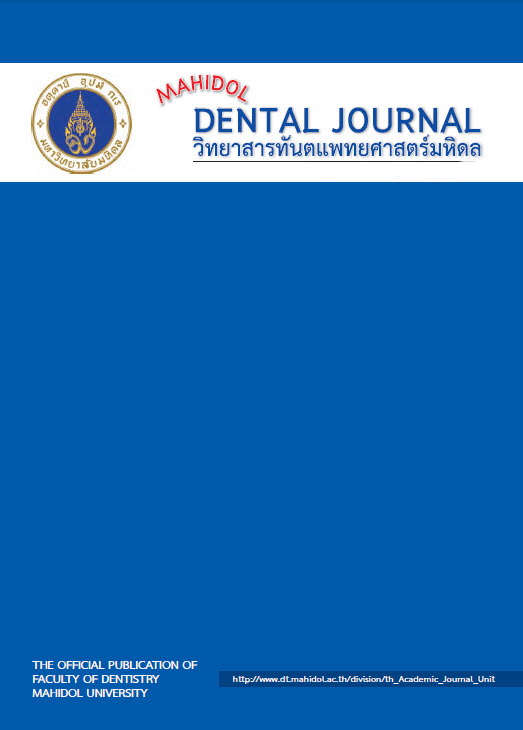Cytotoxicity and Biomineralized Nodule Formation Induced by Tinospora crispa Crude Extract in Human Bone Cells
Main Article Content
Abstract
Objective
To determine the properties of Tinospora crispa crude extract on the cell toxicity and biomineralized nodule formation in human bone cells in Vitro.
Materials and Methods
To test the cytotoxicity of Tinospora crispa crude extract, human bone cells were cultured in 96-well plates and divided into 3 separated groups including 1)the control in alpha-MEM, 2) the control in media plus dimethyl sulfoxide, and 3) the experimental group in media supplemented with different concentrations of Tinospora crispa. Cells were treated for 24 hours before investigating the cell viability by MTT assay.
To examine the induction of biomineralized nodule formation of Tinospora crispa crude extract, human bone cells were cultured in 24-well plates and divided into 3 groups as follows; 1) the negative control cultured in alpha-MEM, 2) the positive control cultured in media plus beta-glycerophosphate and ascorbic acid, 3) the experimental group cultured in media plus Tinospora crispa extract. Cells were treated for 5 weeks before examining by Alizarin Red S staining to observe the orange-red positive stain of biomineralized nodules.
Results
MTT assay showed that human bone cells cultured in Tinospora crispa crude extract with the concentration less than 0.35% (w/v) survived more than 80%. After cells were treated with the Tinospora crispa crude extract for 5 weeks cells were induced to generate biominerlized nodules. Cells in both positive control and Tinospora crispa treated groups were able to form the nodules which were positively stained for Alizarin Red S.
Conclusion
Tinospora crispa crude extract which is less than 0.25% (w/v) is non-toxic to human bone cells. The extract at 0.025% (w/v) can enhance the human bone cells to form biomineralized nodules.
Article Details
References
2. Pihlstrom BL, Michalowicz BS, Johnson NW. Peridontal diseases. Lancet 2005;366:1809-20.
3. กองทันตสาธารณสุข, กรมอนามัย, กระทรวงสาธารณสุข. รายงานผลสำรวจสภาวะทันตสุขภาพแห่งชาติ ครั้งที่ 5 พ.ศ. 2543-2544. ประเทศไทย. กรุงเทพมหานคร: โรงพิมพ์บริษัทสามเจริญพาณิชย์ (กรุงเทพ) จำกัด; 2545.
4. Rosenberg E, Rose LF. Biologic and clinical consideration for autografts and allografts in periodontal regeneration therapy. Dent Clin North Am 1998;42:467-90.
5. Cochran DL, Wozney JM. Biological mediators for periodontal regeneration. Periodontal 2000,1999;19:40-58.
6. Jepsen S, Eberhard J, Herrera D, Needleman I. A systematic review of guide tissue regeneration for periodontal furcation defects. What is the effect of guide tissue regeneration compare with surgical debridement in the treatment of furcation defect? J Clin Peridontol 2002;29:103-16.
7. Raynolds MA, Aichelmann-Reidy ME, Branch-Mays GL, Gunsolley JC. The efficacy of bone replacement grafts in the treatment of periodontal osseous defects. A systematic review. Ann Periodontol 2003;38:227-65.
8. Murphy KG, Gunsolley JC. Guide tissue regeneration for treatment of periodontal intrabony and furcation defects. A systematic review. Ann Peridontol 2003;8:266-302.
9. นันทวัน บุณยะประภัศร. บอระเพ็ด. จุลสารข้อมูลสมุนไพร. 2540;15:6-8.
10. Kongsaktrakoon B, Temsiririrkkul R, Suvitayavat W, Nakormchai S, Wongkrajang Y. The antipyretic effects of Tinospora crispa Mier ex Hook F. & Thoms. Mahidol J Pharm Sci 1994;27:1-6.
11. Dweck A C, Cavin J P. Andawali (Tinospora crispa): a review. Pers Care Mag. 2006;7:33–39.
12. Li S, Long C, Liu F, Lee S, Guo Q, Li R, Liu Y. Herbs for medicinal baths among the traditional Yao communities of China. J Ethnopharmacol. 2006;108:59–67.
13. Ahmad W, Jantan I, Bukhari SN. Tinospora crispa (L.) Hook. f. & Thomson: A Review of Its Ethnobotanical, Phytochemical, and Pharmacological Aspects. Front Pharmacol. 2016;7:59. doi: 10.3389/fphar.2016.00059.
14. Langrand J, Regnault H, Cachet X, Bouzidi C, Villa AF, Serfaty L, Garnier R, Michel S. Toxic hepatitis induced by a herbal medicine: Tinospora crispa. Phytomedicine. 2014;21:1120-23.
15. Ibahim M, I'zzah WNW, Narimah A, Asyikin NZ, Shafinas S-NS, Froemming G. Anti-proliperative and antioxidant effects of Tinosporacrispa (Batawali). Biomed Res. 2011;22:57–62
16. Mossman T. Rapid colorimetric assay for cellular growth and survival; Application to proliferation and cytotoxicity assay. J Immunol Methods. 1983;65:55-63.
17. Freshney RI. Culture of animal cell, a manual of basic technique. 5th ed. New Jersey: John Wiley&Sons,INC;2005:1-9.
18. Freshney RI. Basic principles of cell culture. In: Vunjak-Novakovic G, Freshney RI, editors. Culture of cells for tissue engineering. New Jersey: John Wiley&Sons,INC;2006:4-9
19. Kasugai S, Hasegawa N, Ogura H. A sample in vitro cytoxity test using the MTT (3-(4,5-dimethythiazol-2-yl)-2,5-diphenyl tetrazolium bromide) colorimetric assay: Analysis of eugenol toxicity on dental pulp cells (RPC-C2A). Jpn J Pharmacol. 1990;52:95-100.
20. Alley MC, Scudiero DA, Monks A, Hursey ML, Czerwinski MJ, Fine DL, et al. Feasibility of drug screening with panels of human tumor cell line using a microculture tetrazolium assay. Cancer Res 1988;48:589-601.
21. Vistica DT, Skehan P, Scudiero D, Monks A, Pittman A, Boyd MR. Tetrazolium-based assays for cellular viability: A critical examination of selected parameters affecting formazan production. Cancer Res 1991;51:2515-20.
22. Da Violante G, Zerrouk N, Richard I, Provot G, Chaumeil JC, Arnaud P. Evaluation of the cytotoxicity effect of dimethyl sulfoxide (DMSO) on Caco2/TC7 colon tumor cell cultures. Biol Pharm Bull. 2002;25:1600-03.
23. Chavalittumrong P, Attawish A, Chuthaputti A, Chuntapet P. Toxicological study of crude extract of Tinospora crispa Mier ex Hook F. &Thoms. Thai J Pharm Sci 1997;21:199-210.
24. มงคล โมกขะสมิต, กมล สวัสดีมงคล, ประยุทธ สาตราวาหะ. การศึกษาพิษของสมุนไพรไทย. ว กรมวิทย พ 2513;12:36-66.
25. Kadir FA, Othman F, Abdulla MA, Hussan F, Hassandarvish P. Effect of Tinospora crispa on thioacetamide-induced liver cirrhosis in rats. Indian J Pharmacol. 2011;43:64-68.
26. Humason G. Animal Tissue Technique 3rd ed. San Francisco: WH Freeman and Company; 1972.
27. Abiramasundari G, Sumalatha KR, Sreepriya M. Effects of Tinospora cordifolia (Menispermaceae) on the proliferation, osteogenic differentiation and mineralization of osteoblast model systems in vitro. J Ethnopharmacol. 2012;141:474-80.
28. นิจศิริ เรืองรังษี, พยอม ตันวิวัฒน์. พืชสมุนไพร. กรุงเทพมหานคร: โอ.เอส. พริ้นติ้ง เฮ้าส์;2534:21-22.


